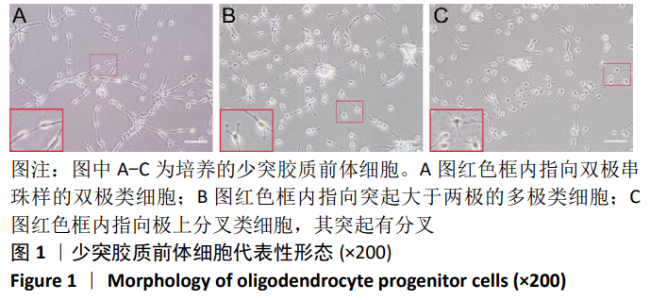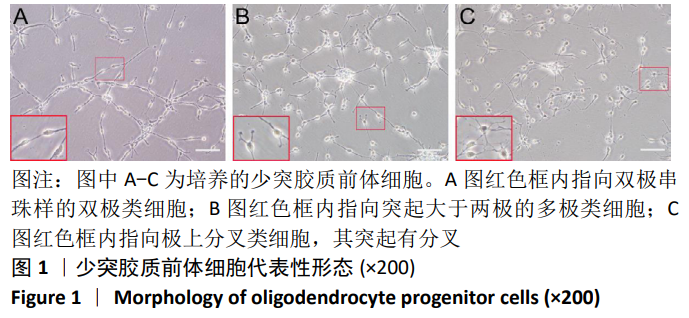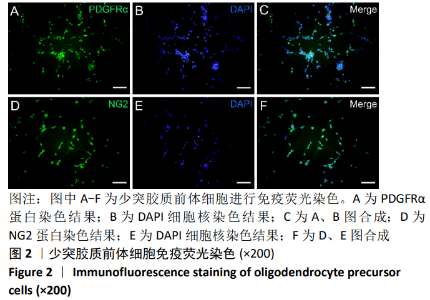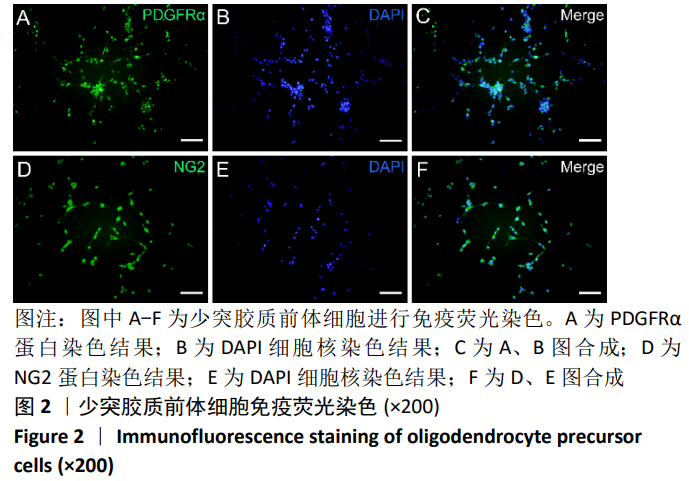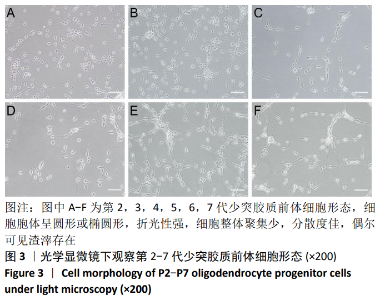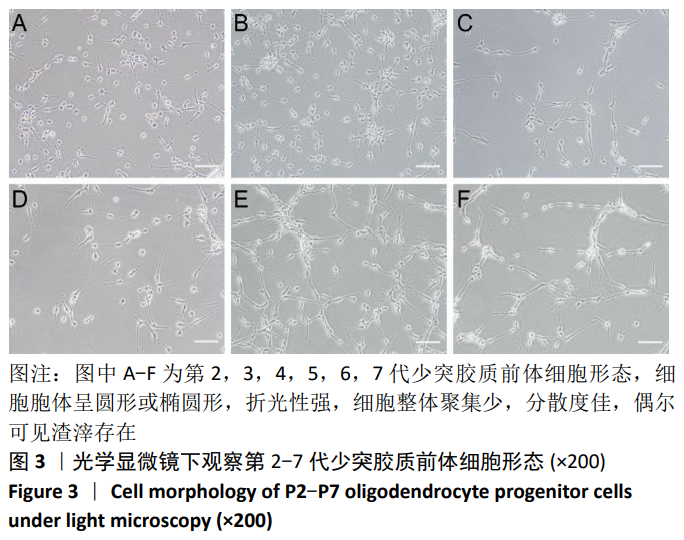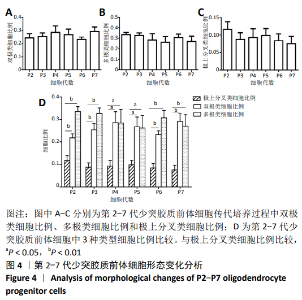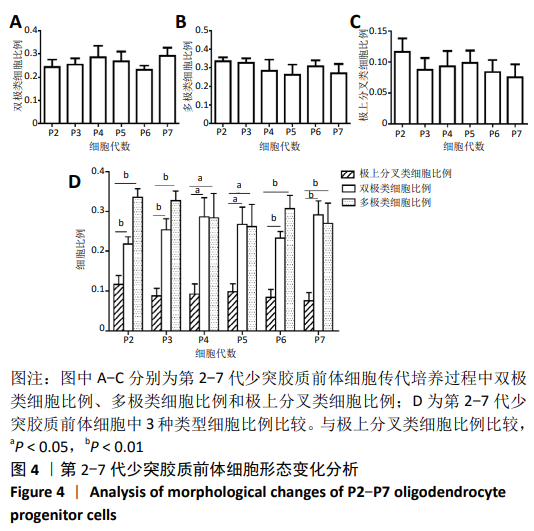Chinese Journal of Tissue Engineering Research ›› 2021, Vol. 25 ›› Issue (7): 1045-1049.doi: 10.3969/j.issn.2095-4344.2170
Previous Articles Next Articles
Morphological changes in human oligodendrocyte progenitor cells during passage
Guan Qian, Luan Zuo, Ye Dou, Yang Yinxiang, Wang Zhaoyan, Wang Qian, Yao Ruiqin
- Xuzhou Medical University, Xuzhou 221004, Jiangsu Province, China
-
Online:2021-03-08Published:2020-12-08 -
Contact:Yao Ruiqin, MD, Professor, Xuzhou Medical University, Xuzhou 221004, Jiangsu Province, China -
About author:Guan Qian, Master, Xuzhou Medical University, Xuzhou 221004, Jiangsu Province, China -
Supported by:the Major National Science and Technology Project, No. 2017YFA0104200
CLC Number:
Cite this article
Guan Qian, Luan Zuo, Ye Dou, Yang Yinxiang, Wang Zhaoyan, Wang Qian, Yao Ruiqin. Morphological changes in human oligodendrocyte progenitor cells during passage[J]. Chinese Journal of Tissue Engineering Research, 2021, 25(7): 1045-1049.
share this article
| [1] DIMOU L, SIMONS M. Diversity of oligodendrocytes and their progenitors. Curr Opin Neurobiol. 2017;47:73-79. [2] BOSHANS LL, SHERAFAT A, NISHIYAMA A. The effects of developmental and current niches on oligodendrocyte precursor dynamics and fate. Neurosci Lett. 2020;715:134593. [3] NISHIYAMA A, BOSHANS L, GONCALVES CM, et al. Lineage, fate, and fate potential of NG2-glia. Brain Res. 2016;1638(Pt B):116-128. [4] 马雪霞.人少突胶质前体细胞体外分化及体内成髓鞘研究[D].广州:南方医科大学,2019. [5] DOMINGUES HS, CRUZ A, CHAN JR, et al. Mechanical plasticity during oligodendrocyte differentiation and myelination. Glia. 2018;66(1):5-14. [6] BUSER JR, MAIRE J, RIDDLE A, et al. Arrested preoligodendrocyte maturation contributes to myelination failure in premature infants. Ann Neurol. 2012;71(1):93-109. [7] BACK SA, LUO NL, BORENSTEIN NS, et al. Late oligodendrocyte progenitors coincide with the developmental window of vulnerability for human perinatal white matter injury. J Neurosci. 2001;21(4):1302-1312. [8] BACK SA. White matter injury in the preterm infant: pathology and mechanisms. Acta Neuropathol. 2017;134(3):331-349. [9] CHEN LX, MA SM, ZHANG P, et al. Neuroprotective effects of oligodendrocyte progenitor cell transplantation in premature rat brain following hypoxic-ischemic injury. PLoS One. 2015;10(3):e0115997. [10] PIAO J, MAJOR T, AUYEUNG G, et al. Human embryonic stem cell-derived oligodendrocyte progenitors remyelinate the brain and rescue behavioral deficits following radiation. Cell Stem Cell. 2015;16(2):198-210. [11] XU L, RYU J, HIEL H, et al. Transplantation of human oligodendrocyte progenitor cells in an animal model of diffuse traumatic axonal injury: survival and differentiation. Stem Cell Res Ther. 2015;6(1):93. [12] KIM TK, PARK D, BAN YH, et al. Improvement by Human Oligodendrocyte Progenitor Cells of Neurobehavioral Disorders in an Experimental Model of Neonatal Periventricular Leukomalacia. Cell Transplant. 2018;27(7): 1168-1177. [13] SKAPER SD. Oligodendrocyte precursor cells as a therapeutic target for demyelinating diseases. Prog Brain Res. 2019;245:119-144. [14] RODRIGUES GMC, GAJ T, ADIL MM, et al. Defined and Scalable Differentiation of Human Oligodendrocyte Precursors from Pluripotent Stem Cells in a 3D Culture System. Stem Cell Reports. 2017;8(6):1770-1783. [15] LI L, TIAN E, CHEN X, et al. GFAP Mutations in Astrocytes Impair Oligodendrocyte Progenitor Proliferation and Myelination in an hiPSC Model of Alexander Disease. Cell Stem Cell. 2018;23(2):239-251.e6. [16] YAMASHITA T, MIYAMOTO Y, BANDO Y, et al. Differentiation of oligodendrocyte progenitor cells from dissociated monolayer and feeder-free cultured pluripotent stem cells. PLoS One. 2017;12(2): e0171947. [17] CUI QL, D’ABATE L, FANG J, et al. Human fetal oligodendrocyte progenitor cells from different gestational stages exhibit substantially different potential to myelinate. Stem Cells Dev. 2012;21(11):1831-1837. [18] CHOI EH, XU Y, MEDYNETS M, et al. Activated T cells induce proliferation of oligodendrocyte progenitor cells via release of vascular endothelial cell growth factor-A. Glia. 2018;66(11):2503-2513. [19] WANG L, SCHLAGAL CR, GAO J, et al. Oligodendrocyte differentiation from human neural stem cells: A novel role for c-Src. Neurochem Int. 2018;120:21-32. [20] LU Y, YANG Y, WANG Z, et al. Isolation and culture of human oligodendrocyte precursor cells from neurospheres. Brain Res Bull. 2015;118:17-24. [21] 汪兆艳,杨印祥,王倩,等.不同保存介质对人少突胶质前体细胞生物学特性的影响[J].中国组织工程研究,2019, 23(29): 4651-4655. [22] WELLIVER RR, POLANCO JJ, SEIDMAN RA, et al. Muscarinic Receptor M3R Signaling Prevents Efficient Remyelination by Human and Mouse Oligodendrocyte Progenitor Cells. J Neurosci. 2018;38(31):6921-6932. [23] NEUMANN B, KAZANIS I. Oligodendrocyte progenitor cells: the ever mitotic cells of the CNS. Front Biosci (Schol Ed). 2016;8:29-43. [24] ESPINOSA-JEFFREY A, BLANCHI B, BIANCOTTI JC, et al. Efficient Generation of Viral and Integration-Free Human Induced Pluripotent Stem Cell-Derived Oligodendrocytes. Curr Protoc Stem Cell Biol. 2016; 38:2D.18.1-2D.18.27. [25] DULAMEA AO. The contribution of oligodendrocytes and oligodendrocyte progenitor cells to central nervous system repair in multiple sclerosis: perspectives for remyelination therapeutic strategies. Neural Regen Res. 2017;12(12):1939-1944. [26] SUO N, GUO YE, HE B, et al. Inhibition of MAPK/ERK pathway promotes oligodendrocytes generation and recovery of demyelinating diseases. Glia. 2019;67(7):1320-1332. [27] ALMEIDA RG, LYONS DA. On Myelinated Axon Plasticity and Neuronal Circuit Formation and Function. J Neurosci. 2017;37(42):10023-10034. [28] NGUYEN LH, ONG W, WANG K, et al. Effects of miR-219/miR-338 on microglia and astrocyte behaviors and astrocyte-oligodendrocyte precursor cell interactions. Neural Regen Res. 2020;15(4):739-747. [29] DOUVARAS P, WANG J, ZIMMER M, et al. Efficient generation of myelinating oligodendrocytes from primary progressive multiple sclerosis patients by induced pluripotent stem cells. Stem Cell Reports. 2014;3(2):250-259. [30] ALL AH, GHARIBANI P, GUPTA S, et al. Early intervention for spinal cord injury with human induced pluripotent stem cells oligodendrocyte progenitors. PLoS One. 2015;10(1):e0116933. [31] SYPECKA J, ZIEMKA-NALECZ M, DRAGUN-SZYMCZAK P, et al. A simple, xeno-free method for oligodendrocyte generation from human neural stem cells derived from umbilical cord: engagement of gelatinases in cell commitment and differentiation. J Tissue Eng Regen Med. 2017; 11(5):1442-1455. [32] WANG C, LUAN Z, YANG Y, et al. High purity of human oligodendrocyte progenitor cells obtained from neural stem cells: suitable for clinical application. J Neurosci Methods. 2015;240:61-66. [33] MATSUSHITA T, AMAGAI Y, SOGA T, et al. A novel oligodendrocyte cell line OLP6 shows the successive stages of oligodendrocyte development: late progenitor, immature and mature stages. Neuroscience. 2005; 136(1): 115-121. [34] FUMAGALLI M, DANIELE S, LECCA D, et al. Phenotypic changes, signaling pathway, and functional correlates of GPR17-expressing neural precursor cells during oligodendrocyte differentiation. J Biol Chem. 2011;286(12):10593-10604. [35] CUI QL, FRAGOSO G, MIRON VE, et al. Response of human oligodendrocyte progenitors to growth factors and axon signals. J Neuropathol Exp Neurol. 2010;69(9):930-944. [36] HAYASHI C, SUZUKI N. Heterogeneity of Oligodendrocytes and Their Precursor Cells. Adv Exp Med Biol. 2019;1190:53-62. |
| [1] | Zhang Chao, Lü Xin. Heterotopic ossification after acetabular fracture fixation: risk factors, prevention and treatment progress [J]. Chinese Journal of Tissue Engineering Research, 2021, 25(9): 1434-1439. |
| [2] | Wu Xun, Meng Juanhong, Zhang Jianyun, Wang Liang. Concentrated growth factors in the repair of a full-thickness condylar cartilage defect in a rabbit [J]. Chinese Journal of Tissue Engineering Research, 2021, 25(8): 1166-1171. |
| [3] | Liu Zhichao, Zhang Fan, Sun Qi, Kang Xiaole, Yuan Qiaomei, Liu Genzhe, Chen Jiang. Morphology and activity of human nucleus pulposus cells under different hydrostatic pressures [J]. Chinese Journal of Tissue Engineering Research, 2021, 25(8): 1172-1176. |
| [4] | Li Jing, Xie Jianshan, Cui Huilin, Cao Ximei, Yang Yanping, Li Hairong. Expression and localization of diacylglycerol kinase zeta and protein kinase C beta II in mouse back skin with different coat colors [J]. Chinese Journal of Tissue Engineering Research, 2021, 25(8): 1196-1200. |
| [5] | Tan Jingyu, Liu Haiwen. Genome-wide identification, classification and phylogenetic analysis of Fasciclin gene family for osteoblast specific factor 2 [J]. Chinese Journal of Tissue Engineering Research, 2021, 25(8): 1243-1248. |
| [6] | Wang Zhengdong, Huang Na, Chen Jingxian, Zheng Zuobing, Hu Xinyu, Li Mei, Su Xiao, Su Xuesen, Yan Nan. Inhibitory effects of sodium butyrate on microglial activation and expression of inflammatory factors induced by fluorosis [J]. Chinese Journal of Tissue Engineering Research, 2021, 25(7): 1075-1080. |
| [7] | Kong Desheng, He Jingjing, Feng Baofeng, Guo Ruiyun, Asiamah Ernest Amponsah, Lü Fei, Zhang Shuhan, Zhang Xiaolin, Ma Jun, Cui Huixian. Efficacy of mesenchymal stem cells in the spinal cord injury of large animal models: a meta-analysis [J]. Chinese Journal of Tissue Engineering Research, 2021, 25(7): 1142-1148. |
| [8] | Shi Yangyang, Qin Yingfei, Wu Fuling, He Xiao, Zhang Xuejing. Pretreatment of placental mesenchymal stem cells to prevent bronchiolitis in mice [J]. Chinese Journal of Tissue Engineering Research, 2021, 25(7): 991-995. |
| [9] | Fan Quanbao, Luo Huina, Wang Bingyun, Chen Shengfeng, Cui Lianxu, Jiang Wenkang, Zhao Mingming, Wang Jingjing, Luo Dongzhang, Chen Zhisheng, Bai Yinshan, Liu Canying, Zhang Hui. Biological characteristics of canine adipose-derived mesenchymal stem cells cultured in hypoxia [J]. Chinese Journal of Tissue Engineering Research, 2021, 25(7): 1002-1007. |
| [10] | Geng Yao, Yin Zhiliang, Li Xingping, Xiao Dongqin, Hou Weiguang. Role of hsa-miRNA-223-3p in regulating osteogenic differentiation of human bone marrow mesenchymal stem cells [J]. Chinese Journal of Tissue Engineering Research, 2021, 25(7): 1008-1013. |
| [11] | Lun Zhigang, Jin Jing, Wang Tianyan, Li Aimin. Effect of peroxiredoxin 6 on proliferation and differentiation of bone marrow mesenchymal stem cells into neural lineage in vitro [J]. Chinese Journal of Tissue Engineering Research, 2021, 25(7): 1014-1018. |
| [12] | Duan Liyun, Cao Xiaocang. Human placenta mesenchymal stem cells-derived extracellular vesicles regulate collagen deposition in intestinal mucosa of mice with colitis [J]. Chinese Journal of Tissue Engineering Research, 2021, 25(7): 1026-1031. |
| [13] | Song Chengjie, Chang Hengrui, Shi Mingxin, Meng Xianzhong. Research progress in biomechanical stability of lateral lumbar interbody fusion [J]. Chinese Journal of Tissue Engineering Research, 2021, 25(6): 923-928. |
| [14] | Xie Yang, Zhang Shujiang, Liu Menglan, Luo Ying, Yang Yang, Li Zuoxiao. Mechanism by which rapamycin protects spinal cord neurons in experimental autoimmune encephalomyelitis mice [J]. Chinese Journal of Tissue Engineering Research, 2021, 25(5): 695-700. |
| [15] | Ma Binxiang, He Wanqing, Zhou Guangchao, Guan Yonglin. Triptolide improves motor dysfunction in rats following spinal cord injury [J]. Chinese Journal of Tissue Engineering Research, 2021, 25(5): 701-706. |
| Viewed | ||||||
|
Full text |
|
|||||
|
Abstract |
|
|||||
